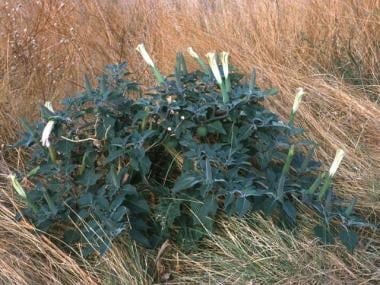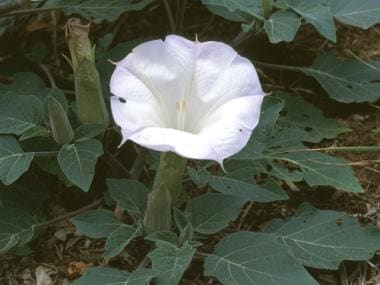Practice Essentials
The tropane alkaloids atropine, scopolamine, and hyoscyamine are highly anticholinergic compounds found in a number of plants. Alkaloids are plant metabolites that have a nitrogen-containing chemical ring structure, alkali-like chemical reactivity, and pharmacologic activity. [1] The alkaloids represent a very diverse group of medically significant compounds that include well-known drugs such as the opiates. A subgroup of the alkaloids is the alkaloid amines, which include three major pharmacologic groups: the hallucinogenic alkaloid amines, the stimulant alkaloid amines, and the tropane alkaloids (also called the belladonna alkaloids or bicyclic alkaloids). [2]
Plants that contain tropane alkaloids include the following:
-
Hyoscyamus niger (henbane)
-
Mandragora officinarum (mandrake)
All of these plants have long histories of use connected with sorcery, witchcraft, native medicine, and magico-religious rites, dating back to 1500 BC and Homer's Odyssey. (Homer's use of the plant moly as an antidote to Circe's poisonous anticholinergic drugs may have been the first recorded use of an anticholinesterase to reverse central anticholinergic intoxication.)
Chinese herbal medicines containing tropane alkaloids have been used to treat asthma, chronic bronchitis, pain, and flu symptoms. In Mexico, Datura (see the images below) is taken by Yaqui women to lessen pain of childbirth. In Africa, a common use of Datura is smoking the leaves to relieve asthma and pulmonary problems. Many cultures worldwide add plants with tropane alkaloids (particularly Datura species) to alcoholic beverages to increase intoxication.
 Datura stramonium (close-up of unripe seed pods). Note spiny appearance of pods.© 2000 Richard Wagner
Datura stramonium (close-up of unripe seed pods). Note spiny appearance of pods.© 2000 Richard Wagner
Recently, Datura has been used as a recreational hallucinogen in the United States, resulting in sporadic cases of anticholinergic poisoning and death. Among the most commonly reported desired effects, euphoria, surreal interactions with world, and auditory hallucinations have been frequently reported by recreational users. After oral intake, the effects may arise in around 20-30 minutes, depending on the dose; if smoked, the onset of effects is faster (around 5 minutes). After the intake of moderate doses, the effects last approximately 8-12 hours; with higher doses, effects may last 2-3 days. [7]
Long-term consumption of Datura resulting in the onset of paranoid schizophrenia, an altered state of consciousness, and aggressive behaviour has been reported. [8]
Numerous cases of anticholinergic poisoning also have resulted from belladonna alkaloid contaminants in foods, including commercially purchased Paraguay tea (an herbal tea derived from Ilex paraguariensis), hamburger, honey, [9] stiff porridge made from contaminated millet, and homemade "moon flower" wine. An outbreak of anticholinergic posoning in Uganda in 2019 was attributed to a cereal distributed by the World Food Programme. The cereal was found to have been contaminated with tropane alkaloids from seeds of Datura stramonium that had invaded grain fields. [10]
Other accidental ingestions include misuse as an edible wild vegetable [11] and inclusion in homemade toothpaste, [12] as well as a large epidemic in New York and the eastern US that resulted from heroin contaminated with scopolamine. [13]
Although most tropane alkaloids cause an anticholinergic syndrome, a case report indicates that the tropane alkaloid–containing medicinal herb Erycibe henri Prain ("Ting Kung Teng") contains a tropane alkaloid that may cause a cholinergic syndrome, as well as kidney, liver, and erythrocyte toxicity. [14] This is considered atypical for the tropane alkaloids, which are predominantly strongly anticholinergic.
See 11 Common Plants That Can Cause Dangerous Poisonings, a Critical Images slideshow, to help identify plant reactions and poisonings.
For patient education information, see Poisoning Treatment.
Pathophysiology
Toxicity from plants containing tropane alkaloids manifests as classic anticholinergic poisoning. Symptoms usually occur 30-60 minutes after ingestion and may continue for 24-48 hours because tropane alkaloids delay gastric emptying and absorption.
Scopolamine, acting as an antagonist at both peripheral and central muscarinic receptors, is thought to be the primary compound responsible for the toxic effects of these plants. Tropane alkaloids are found in all parts of the plants, with highest concentrations in roots and seeds.
Atropine is an artifact of purification, produced by racemization of l-hyoscyamine. The proportion of each alkaloid present varies among species, time of year, location, and part of plant. As little as one-half teaspoon of Datura seed, equivalent to 0.1 mg of atropine per seed, has caused death from cardiopulmonary arrest. The usual route of ingestion is as a tea, although ingesting seeds or other plant parts and smoking dried leaves also are common.
Epidemiology
Incidence is sporadic, with clusters of poisoning cases, mostly among adolescents using plants for their hallucinogenic effects.
According to the American Association of Poison Control Centers' National Poison Data System Annual Report, 728 single exposures to anticholinergic plants were reported in 2021; 115 of those were treated in health care facilities. Major outcome occurred in one case, but no deaths were documented. [15]
During 1998-2004, a total of 188 reported human exposures were identified by Texas Poison Control Centers. [16] Seventy-six percent of the exposures occurred in June-October, 82% of the cases occurred in males, and 72% of cases occurred in those aged 13-19 years.
Widespread access to information on hallucinogenic plants through the Internet may lead to a further increase in the incidence.
Worldwide incidence is unknown. However, cases have been reported in Germany, Italy, Greece, Saudi Arabia, Tanzania, Australia, Brazil, Hong Kong, Taiwan, Mexico, Chile, and Venezuela, attesting to broad geographic distribution of Datura species.
An outbreak in Uganda in 2019, attributed to a cereal distributed by the World Food Programme contaminated with tropane alkaloids from seeds of Datura stramonium that had invaded grain fields, caused over 300 hospitalizations and 5 deaths. [10]
In July 2021, a group of 10 migrant workers in a remote province of China experienced symptoms consistent tropane alkaloid poisoning after eating a local plant in the Solanaceae family, Anisodus tanguticus, having mistaken it for a wild vegetable. All 10 required hospitalization, four with severe neurotoxic symptoms. One death was reported. [17]
Males are more frequently involved in cases of intentional exposure.
No age predilection exists, although Datura use as a recreational drug is more common among adolescents. Accidental ingestion and resultant toxicity in children has been reported.
Prognosis
Published reports of tropane alkaloid poisoning may not accurately characterize the prognosis for these patients, as nonfatal cases are likely underreported. However, sporadic cases or clusters of cases involving intentional use as a hallucinogen are frequently reported; most patients recover uneventfully, although fatalities do occur. [18] Of the hundreds of anticholinergic plant poisonings reported to the American Association of Poison Control Centers each year, few or none prove fatal. [15] Related deaths from drowning, exposure, and lack of supportive care have been reported.
-
Datura stramonium (jimson weed). Note 4-5 inch long white flowers.© 2000 Richard Wagner
-
Datura stramonium flower. Note the trumpetlike shape.© 2000 Richard Wagner
-
Datura stramonium (close-up of unripe seed pods). Note spiny appearance of pods.© 2000 Richard Wagner
-
Datura stramonium is the plant shown. © 2000 Richard Wagner
-
The plant shown is foxglove (Digitalis purpura), which contains cardiac glycosides, not tropane alkaloids. © 2000 Richard Wagner











